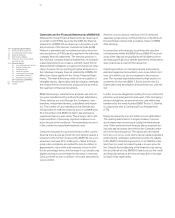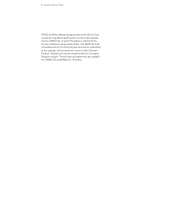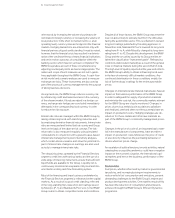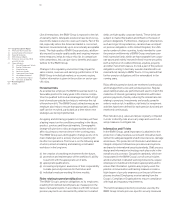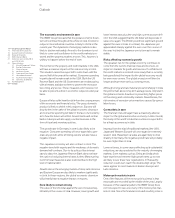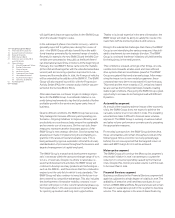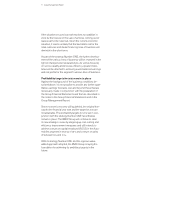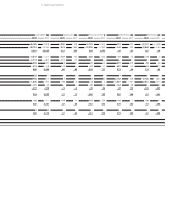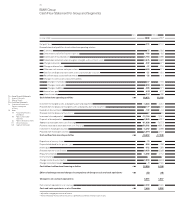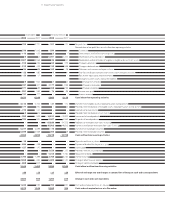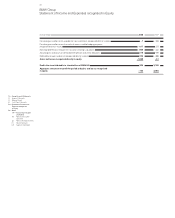BMW 2008 Annual Report Download - page 67
Download and view the complete annual report
Please find page 67 of the 2008 BMW annual report below. You can navigate through the pages in the report by either clicking on the pages listed below, or by using the keyword search tool below to find specific information within the annual report.
68
14 Group Management Report
14 A Review of the Financial Year
16 General Economic Environment
20 Review of Operations
42 BMW Stock and Bonds
45 Disclosures pursuant to § 289 (4)
and § 315 (4) HGB
47 Financial Analysis
47 Internal Management System
49 Earnings Performance
51 Financial Position
52 Net Assets Position
55 Subsequent Events Report
55 Value Added Statement
57 Key Performance Figures
58 Comments on BMW AG
62 Risk Management
68 Outlook
Outlook
The economic environment in
The BMW Group forecasts that the global economic down-
turn will continue throughout the whole of . Economic
output in most industrial countries is likely to shrink in the
current year. The dynamism of emerging markets is also
likely to slacken noticeably. An end to the downturn is not
likely to come until confidence in the credit markets is re-
stored and the property markets recover. This, however, is
unlikely to happen before the end of .
The turmoil on the property and credit markets in the USA
will have a massive impact on the real economy in .
The situation cannot be expected to calm down until the
second half of the year at the earliest. Consumer spending
in particular will remain weak in the USA. Both the US
Reserve Bank and the US Government are endeavouring
with all means available to them to prevent the recession
becoming any worse. These measures will, however, not
be able to prevent a drop in economic output on a full year
basis.
Europe will also suffer heavily in from the consequences
of the economic and financial crisis. The gross domestic
product is likely to shrink in this region too. Exports will
drop further in the wake of the global economic downturn
and consumer spending will falter in the face of uncertainty
as to how the future will unfold. Governments and central
banks in Europe will also apply countermeasures in the
form of fiscal and monetary policies.
The growth rate in Germany in is also likely to be
negative. Consumer spending will once again fail to gen-
erate any growth, while shrinking exports will also have a
negative impact.
The Japanese economy will also contract in . The
negative trend with exports and the weakness of domestic
demand will continue. Due to its policy of low interest
rates
to date, the Japanese Reserve Bank does not have
the option of reducing interest rates further. Manoeuvring
room for fiscal measures is also restricted due to the high
level of national debt.
Growth rates in the emerging markets of Asia, Latin America
and Eastern Europe are also likely to weaken significantly
in . In these regions, the global economic downturn
will primarily have a negative impact on exports.
Euro likely to remain strong
The value of the US dollar against the euro increased sig-
nificantly in the course of . However, lower growth and
lower interest rates plus the very high current account defi-
cit in the USA suggest that the US dollar will depreciate in
value once again. The British pound lost significant ground
against the euro in . In contrast, the Japanese yen
appreciated sharply against the euro over the course of
the
year. In , the Japanese yen is forecast to remain
stable.
Risks affecting economic growth
The greatest risk for the global economy continues to
come from the world’s financial crisis and its knock-on
impact on markets for goods and services. If confidence in
the credit markets is restored more slowly than is currently
being predicted, the impact for the global economy would
be even more severe. The global recession will then be
longer and have more serious consequences.
Although energy and raw material prices fell sharply in ,
they still remain above long-term average levels. At present,
the global economic downturn is preventing higher prices
on the energy and commodity markets. Nevertheless, the
risk remains of excessive price reactions caused by specu-
lative forces.
Car markets in
The financial crisis will again have a massively adverse
impact on the global automotive economy in . Overall,
the slump in the world’s industrial countries is expected to
be at least as severe as in .
Impetus from the triad of traditional markets (the USA,
Japan and Western Europe) will once again be extremely
weak in . Passenger car sales are again likely to drop
sharply. In Germany, the negative growth rate will probably
be even higher than in .
Lower volumes, in some cases reflecting quite substantial
reductions, are also predicted for the majority of emerging
markets. Even markets such as China and India which
have
experienced extreme high growth rates up to now
are likely
to see fewer new registrations. In Russia the
reduction could even reach the double-digit range. The
same applies to most markets in Eastern Europe and
Latin America.
Motorcycle markets in
One of the features of the motorcycle business is that
most
sales are recorded by the middle of the year. Largely
because of this seasonal pattern, the BMW Group does
not now expect to see a recovery of the motorcycles mar-
kets in . Since the financial crisis and resulting crisis in


